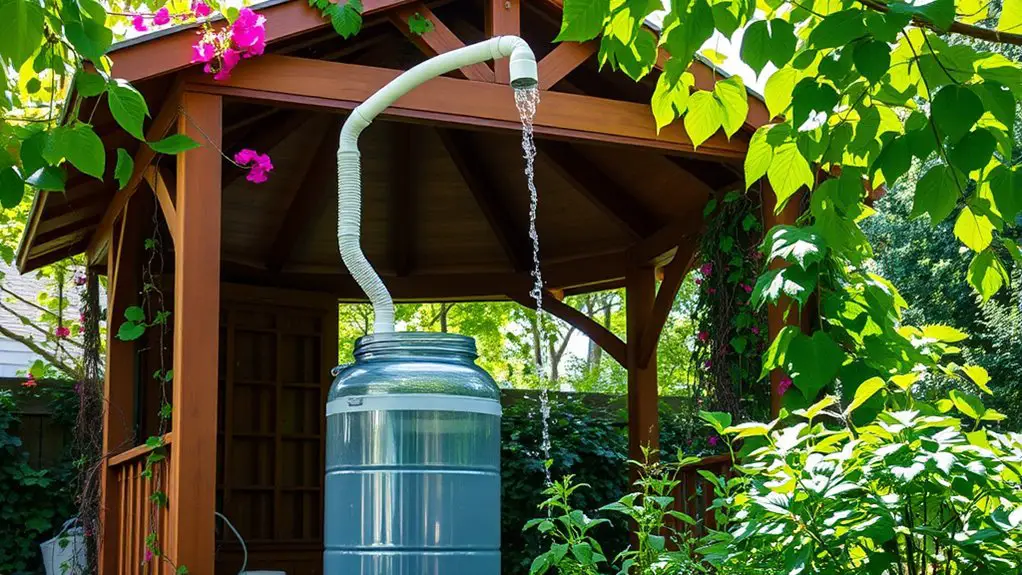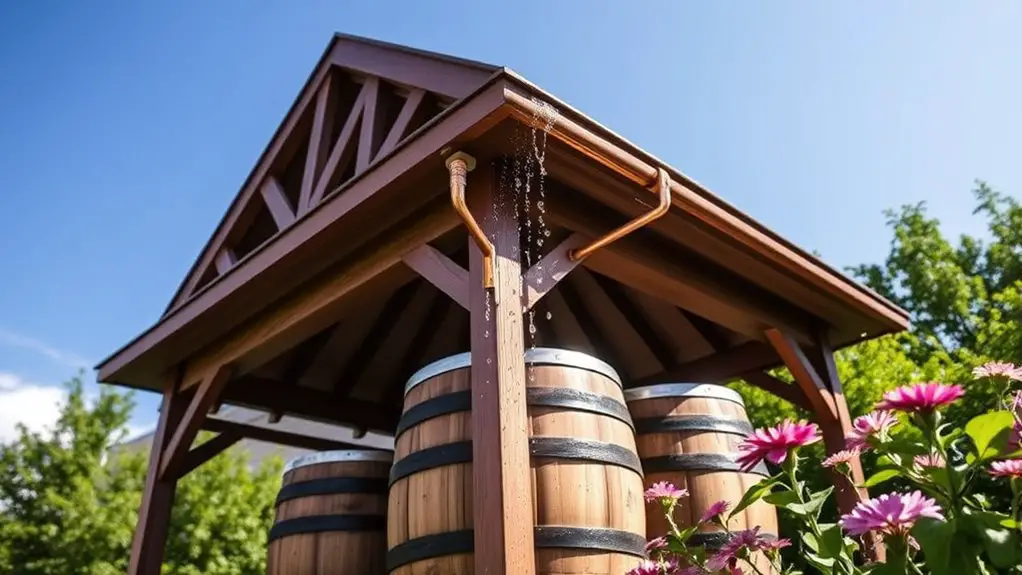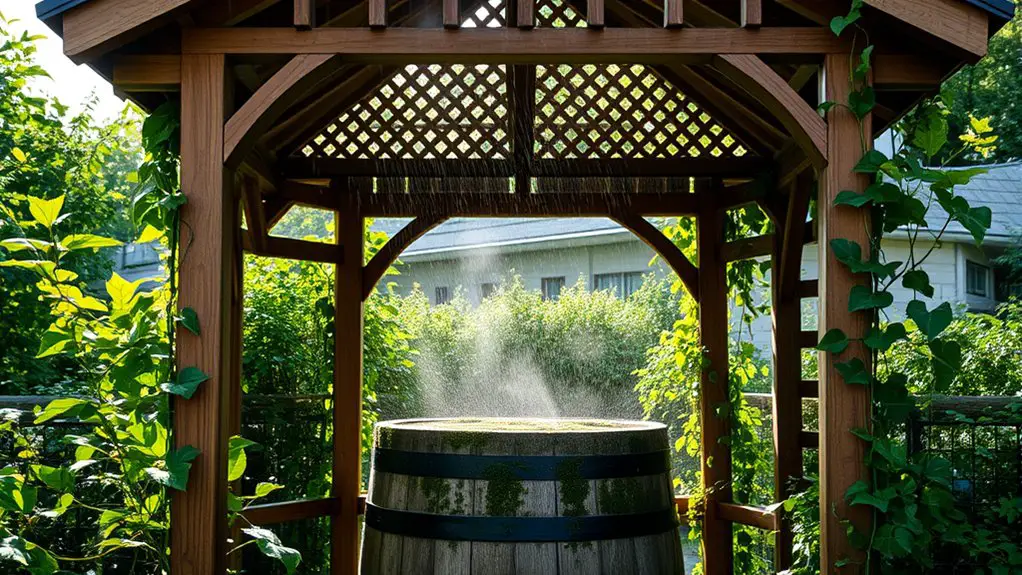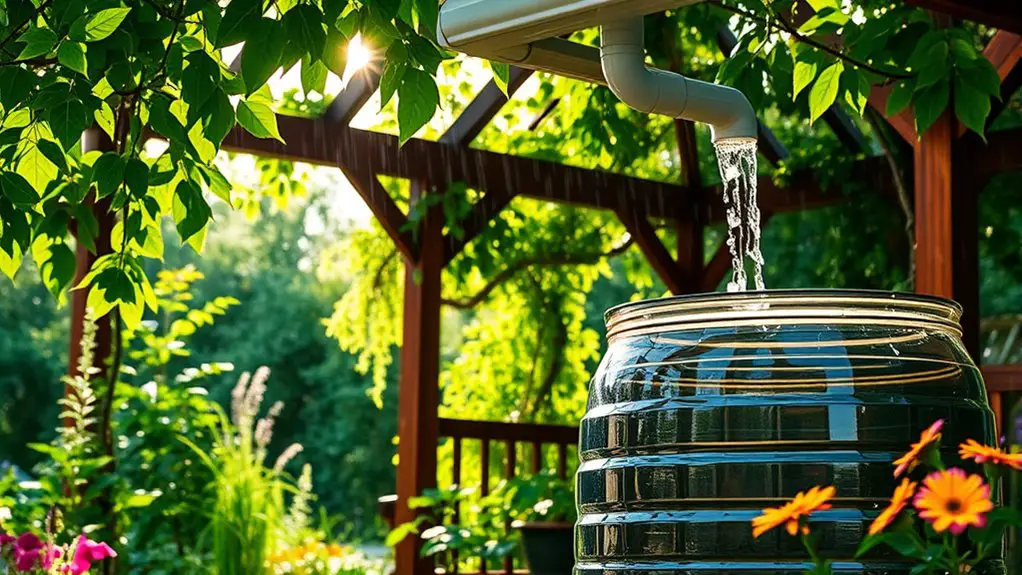To use rainwater collection in your gazebo, start by designing an efficient system with suitable materials like recycled metal and food-grade polyethylene. Install gutters with a slight slope to direct water into downspouts. Position these to maximize flow toward a storage tank situated nearby for easy access. Enhance water quality with filtration options and guarantee proper drainage to protect your gazebo. This sustainable approach not only conserves water but also supports a thriving outdoor space, revealing more insights on effective methods ahead.
Understanding Rainwater Harvesting

While many may overlook the potential of rainwater harvesting, it serves as a sustainable solution for managing water resources efficiently. By capturing and utilizing rainwater, you not only reduce dependency on municipal supplies but also contribute to conservation techniques that enhance your autonomy. The rainwater benefits are numerous; it can be used for irrigation, reducing your water bill, and replenishing groundwater levels.
Implementing a rainwater harvesting system in your gazebo can provide a practical source of water for both ornamental plants and functional uses. The initial setup may involve gutters, downspouts, and storage tanks, but the long-term gains outweigh these considerations.
Moreover, embracing this practice empowers you to take control of your water resources, aligning with a sustainable lifestyle that prioritizes environmental stewardship. Ultimately, understanding rainwater harvesting equips you with the tools to foster self-sufficiency and promote ecological balance.
Choosing the Right Materials
When setting up a rainwater harvesting system in your gazebo, selecting the right materials is key to ensuring efficiency and longevity. Start with sustainable materials that minimize environmental impact, such as bamboo or recycled metal for the structure. These choices not only contribute to sustainability but also enhance the overall aesthetic of your gazebo.
For the collection system, consider using food-grade polyethylene or stainless steel; both are durable and resistant to corrosion. Your downspouts should be made of PVC or similar materials, ensuring they can withstand various weather conditions.
While functionality is essential, don’t overlook aesthetic choices. Opt for colors and designs that harmonize with your gazebo’s style, creating an inviting atmosphere. By prioritizing sustainable materials alongside appealing aesthetics, you’ll create a rainwater collection system that serves both practical and visual purposes, giving you the freedom to enjoy your outdoor space responsibly.
Designing the Collection System

To effectively design your rainwater collection system, it’s crucial to assess the specific dimensions and layout of your gazebo, as these factors will influence the system’s efficiency. Begin by identifying the roof surface area; this will determine the potential water volume you can collect. Consider the slope and angle of your gazebo roof—optimal angles enhance runoff.
Next, think about the placement of your collection system. Ideally, you’ll want to position it to maximize water flow towards your storage tank while minimizing any potential obstructions. Integrate filtration options to guarantee water quality, especially if you plan to use it for irrigation.
Lastly, evaluate the materials used in your gazebo design; they should be compatible with your collection system to prevent contamination. By meticulously planning these elements, you’ll create a sustainable rainwater collection system that aligns with your desire for freedom and independence from conventional water sources.
Installing Gutters and Downspouts
As you commence on installing gutters and downspouts for your gazebo’s rainwater collection system, it’s essential to guarantee they’re strategically positioned to optimize water capture. Begin with gutter installation along the roof edges, ensuring they slope slightly toward the downspouts. This angle facilitates efficient drainage, minimizing water pooling and overflow.
Next, focus on downspout placement; position them at the corners or mid-length of the sides for maximum efficiency. Ideally, each downspout should handle a specific section of the gutter system to evenly distribute water flow.
Use high-quality materials to enhance durability and reduce maintenance needs, as sustainability is key in your setup. Consider integrating leaf guards to prevent debris accumulation, ensuring unobstructed water flow. With careful planning in your gutter installation and downspout placement, you’ll create an effective rainwater collection system that serves both your gazebo and the environment.
Creating a Storage Solution

When creating a storage solution for your rainwater collection, you’ll need to carefully consider the type of container that best suits your needs. Placement and accessibility are essential for efficient use and maintenance, ensuring you can easily access the water while keeping it clean. Regular cleaning and upkeep will maximize the longevity and functionality of your storage system.
Choosing Storage Container Type
Choosing the right storage container for your rainwater collection system is essential, especially if you want to maximize efficiency and sustainability. The container you select will depend on your specific needs, including tank materials and container sizes. Here are three options to contemplate:
- Plastic Tanks: Lightweight and corrosion-resistant, they’re available in various sizes, making them versatile for different setups.
- Metal Tanks: Durable and long-lasting, they offer excellent protection against UV rays but can be heavier and more expensive.
- Concrete Tanks: Ideal for larger systems, they provide insulation and stability but require significant space and effort to install.
Placement and Accessibility Considerations
While it’s crucial to select the right storage container for your rainwater collection system, where you place it can greatly impact its efficiency and usability. Effective location selection should prioritize user convenience; positioning your storage unit near the gazebo minimizes water transport distance. Verify the site is level and accessible for maintenance and refilling, avoiding areas prone to flooding or debris accumulation. Consider sun exposure, as shading can reduce evaporation, and proximity to your garden or plants can enhance usability. Additionally, think about aesthetics and how the container integrates with your gazebo’s design without compromising functionality. Balancing these factors will maximize your rainwater collection system’s effectiveness while maintaining the freedom to utilize your collected resources effortlessly.
Maintenance and Cleaning Tips
Proper maintenance and cleaning of your rainwater storage solution is essential for guaranteeing the quality of the collected water and the longevity of the system. Establishing a regular cleaning schedule will help you avoid contamination and maintain efficiency. Here’s a simple maintenance checklist to keep in mind:
- Inspect the System Monthly: Check for debris, leaks, or blockages in gutters and downspouts.
- Clean Filters and Screens Bi-Annually: Remove and wash filters to prevent algae growth and guarantee maximum flow.
- Empty and Clean the Tank Annually: Drain the tank and scrub the interior to remove sediment and prevent bacterial buildup.
Ensuring Proper Drainage
To effectively manage rainwater collection in a gazebo, guaranteeing proper drainage is essential for preventing water accumulation and potential structural damage. Start by evaluating your site’s topography to direct water flow away from the gazebo. Implementing effective drainage solutions, like a sloped foundation or strategically placed gutters, can considerably enhance water management.
Consider using permeable materials in the gazebo’s flooring to allow excess water to filter through, reducing puddling. Incorporating drainage pipes can also channel rainwater efficiently, minimizing the risk of overflow. Additionally, choosing a concrete slab foundation can provide a durable base that enhances drainage efficiency.
Regularly inspect your drainage systems to guarantee they’re functioning correctly; any blockage can disrupt water flow and lead to unwanted pooling. By prioritizing these drainage solutions, you not only safeguard the gazebo’s structure but also embrace a sustainable approach to rainwater collection. Proper drainage not only enhances the gazebo’s longevity but also fosters an environment that values freedom from water-related concerns.
Utilizing Collected Water Efficiently
By harnessing the rainwater collected in your gazebo, you can greatly reduce your reliance on municipal water sources and promote sustainability. Efficiently utilizing this resource not only supports water conservation but also empowers you to implement effective irrigation strategies. Here are three ways to make the most of your collected water:
- Garden Irrigation: Use the rainwater for drip irrigation systems to minimize waste and deliver moisture directly to plant roots.
- Landscape Maintenance: Water your lawn and flower beds with stored rainwater during dry spells, ensuring your landscape thrives while lowering your water bills.
- Outdoor Cleaning: Utilize the collected water for washing outdoor furniture, decks, and pathways, reducing your demand for treated water.
Frequently Asked Questions
Can I Collect Rainwater in a Gazebo Year-Round?
Yes, you can achieve year-round collection of rainwater with a well-designed gazebo. Proper gazebo design, including gutters and storage systems, guarantees efficient water capture, promoting sustainability while providing you with freedom in resource management.
What Maintenance Is Required for a Rainwater Collection System?
For your rainwater collection system, you’ll need regular filter cleaning and tank inspection. This maintenance guarantees ideal water quality and system efficiency, promoting sustainable practices while granting you the freedom to utilize harvested rainwater effectively.
Is Rainwater Safe for Drinking After Treatment?
You’d think rainwater’s a magic elixir, but after proper rainwater treatment, it can be safe for drinking. Ensuring its purity is essential, offering a sustainable option that grants you freedom from conventional water sources.
How Can I Prevent Mosquitoes in My Rainwater Storage?
To prevent mosquitoes in your rainwater storage, guarantee proper water filtration and cover containers tightly. Regularly check for debris and employ natural repellents, promoting sustainable practices while maintaining water quality and enjoying your freedom from pests.
What Local Regulations Apply to Rainwater Harvesting?
When considering rainwater harvesting, you’ll need to check local guidelines regarding harvesting permits. Ensuring compliance with regulations helps you maximize sustainability while enjoying the freedom to utilize natural resources effectively for your needs.

